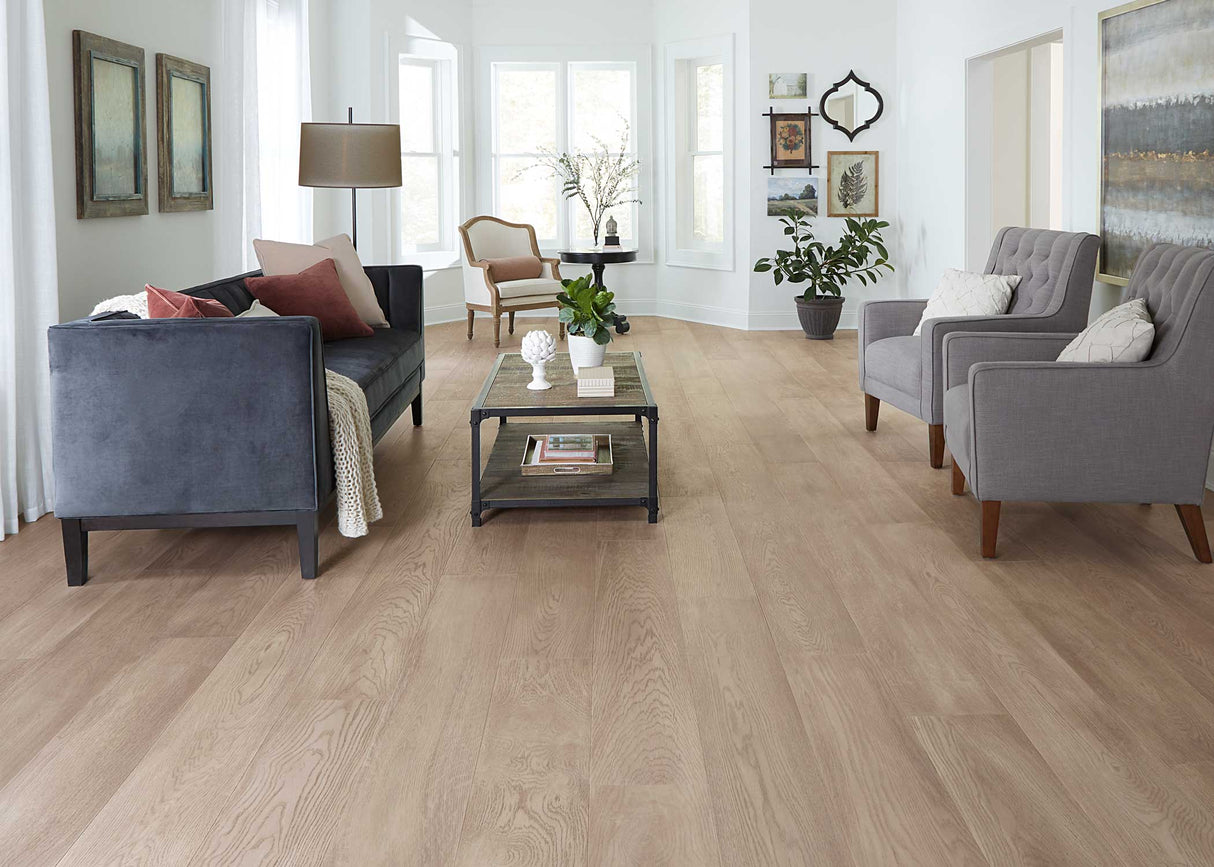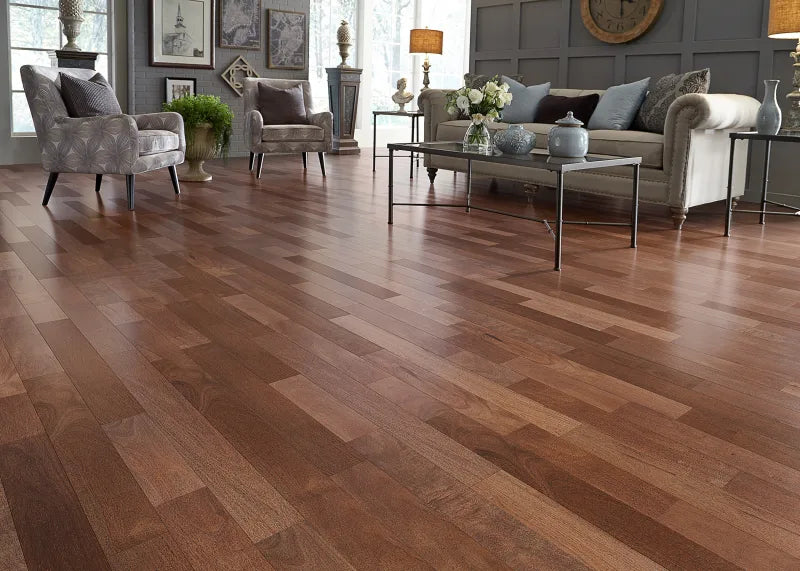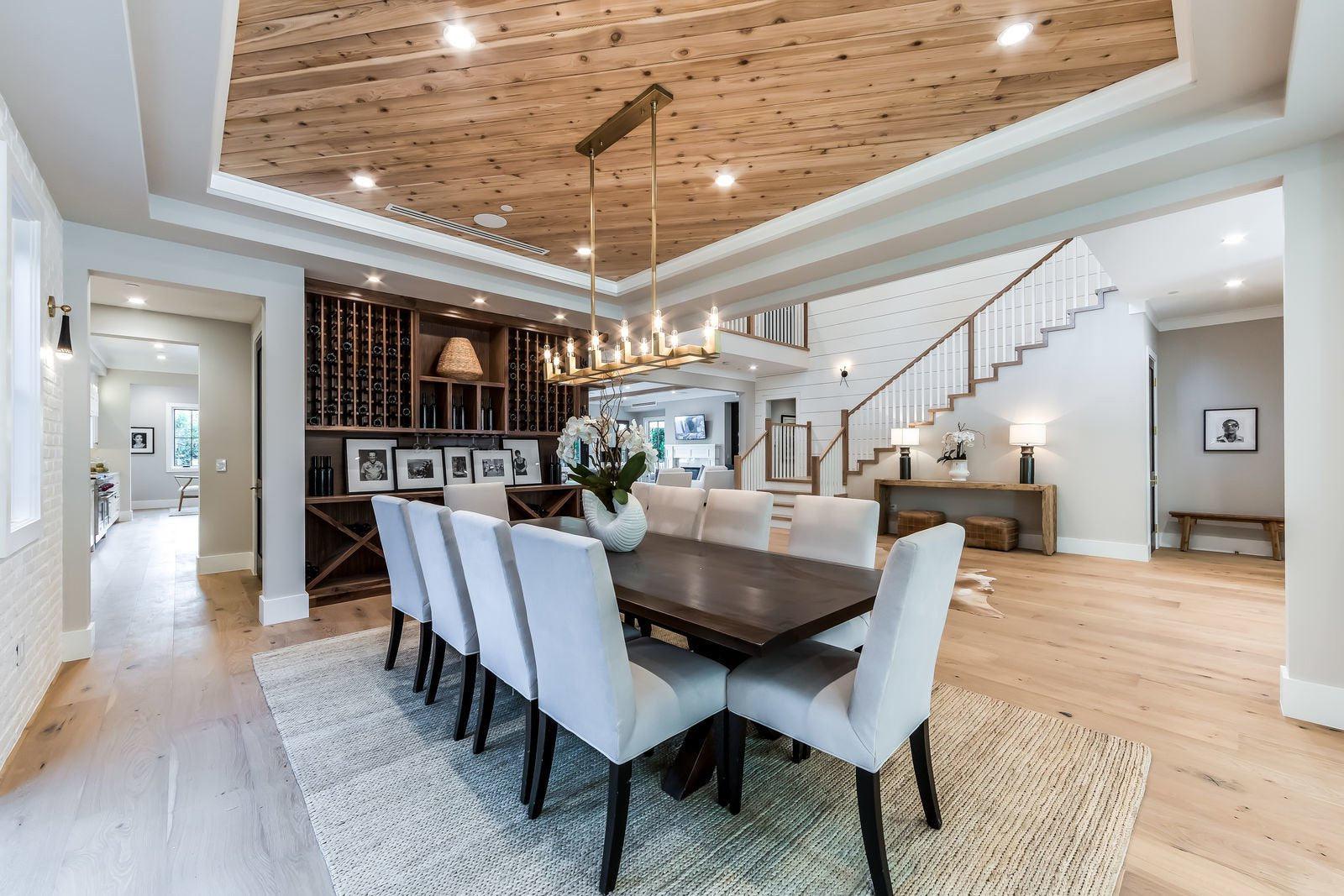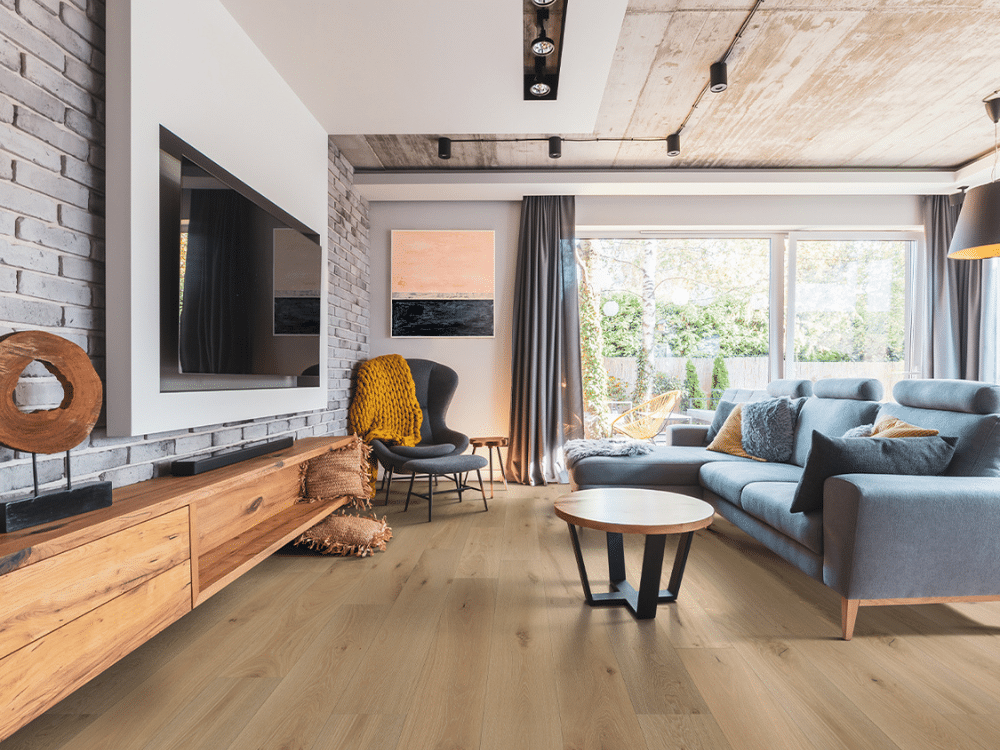Are you considering new flooring for your home? Let’s delve into the world of 5/8 engineered hardwood flooring, a popular choice for homeowners seeking the perfect blend of durability, beauty, and value. This guide explores everything you need to know about this versatile flooring option, from its composition and advantages to maintenance and styling, ensuring you make an informed decision for your space.
Understanding 5 8″ Engineered Hardwood Flooring: A Comprehensive Guide

Engineered hardwood flooring has revolutionized the flooring industry, offering a robust and aesthetically pleasing alternative to traditional solid hardwood. Its multi-layered construction provides enhanced stability and resistance to moisture, making it suitable for various environments within your home. When considering engineered hardwood, the thickness of the plank is a crucial factor, with 5/8 engineered hardwood flooring representing a sweet spot for many homeowners, balancing cost, performance, and feel. Understanding the nuances of this specific thickness will help you navigate the market and select the best option for your needs.
Definition and Composition
5 8 engineered hardwood flooring refers to flooring planks that measure 5/8 of an inch in overall thickness. Unlike solid hardwood, which is a single piece of wood, engineered hardwood is composed of multiple layers. Typically, a top layer, known as the veneer or wear layer, is made of real hardwood, providing the desired aesthetic appeal. This veneer can be any wood species, from classic oak and maple to exotic choices like Brazilian cherry or walnut. Below the veneer lies a core, often constructed from multiple layers of plywood, high-density fiberboard (HDF), or a similar composite material. These layers are bonded together under heat and pressure in alternating directions, creating a stable and durable core that resists warping and expansion, particularly in environments with fluctuating humidity levels.
The number of core layers and the materials used can vary depending on the manufacturer and the quality of the flooring. Higher quality engineered hardwood tends to have a thicker veneer and a denser, more stable core, contributing to its longevity and resistance to wear and tear. The composition directly impacts the flooring’s durability, stability, and even its ability to be refinished. A thicker wear layer, for instance, allows for more sanding and refinishing over the years, extending the floor’s lifespan.
The beauty of engineered hardwood lies in its ability to offer the visual appeal of solid wood while mitigating some of the challenges associated with it. The dimensional stability of the engineered construction is particularly valuable in areas prone to moisture, such as basements or kitchens, where solid hardwood may not be a suitable choice. The layered construction also contributes to a more uniform and consistent product, reducing the likelihood of imperfections and ensuring a more predictable installation process.
Differences Between Engineered and Solid Hardwood
The fundamental difference between engineered and solid hardwood lies in their construction. As mentioned, solid hardwood is a single piece of wood, cut and milled from a tree. Engineered hardwood, conversely, is a composite product. This difference in construction impacts several key aspects, including stability, cost, installation, and environmental considerations. Solid hardwood is susceptible to expansion and contraction with changes in humidity and temperature, potentially leading to warping, cupping, or gapping. Engineered hardwood, with its multi-layered core, is much more dimensionally stable and less prone to these issues.
From a cost perspective, engineered hardwood is generally more affordable than solid hardwood, especially when considering wider planks or exotic wood species. The lower cost of the core materials and the more efficient use of hardwood resources contribute to this price difference. Installation also differs significantly. Solid hardwood typically requires nailing or stapling to a subfloor, whereas engineered hardwood can be installed using a variety of methods, including gluing, floating, or nailing. The floating installation method, in particular, is popular for DIY projects as it is relatively straightforward and does not require specialized equipment.
However, solid hardwood offers certain advantages as well. With its greater thickness, solid hardwood can be refinished more times than most engineered hardwood options, potentially extending its lifespan significantly. Refinishing involves sanding down the surface to remove scratches and imperfections and then applying a new finish. The number of times a floor can be refinished depends on the thickness of the wear layer. While some 5/8 engineered hardwood flooring products offer a veneer thick enough for a refinishing or two, solid hardwood generally provides more opportunity for restoration.
Finally, environmental considerations play a role in the choice between engineered and solid hardwood. Engineered hardwood uses less solid wood per plank, making it a more sustainable option in some cases, especially when sourced from responsibly managed forests. However, the manufacturing process of engineered hardwood can involve the use of adhesives and other chemicals, which may impact indoor air quality. Look for products that are certified low-VOC (volatile organic compounds) to minimize these risks.
The Importance of Thickness in Flooring
The thickness of your flooring is a critical factor that directly influences its performance, durability, and longevity. With engineered hardwood, the overall thickness, as well as the thickness of the wear layer, are essential considerations. A thicker plank, such as 5/8 engineered hardwood flooring, generally offers more stability and a more substantial feel underfoot compared to thinner options. This added thickness can also provide better sound insulation and thermal resistance.
The thickness of the wear layer is equally, if not more, important. This is the actual hardwood veneer that you see and walk on. A thicker wear layer allows for more refinishing over the years, extending the lifespan of the floor. Products with a very thin veneer may only withstand light sanding once, if at all, limiting their long-term appeal.
The overall thickness of the plank also impacts its compatibility with other flooring types in your home. If you are replacing flooring in one room and want it to be level with the adjacent room, the thickness of the new flooring needs to be carefully considered. A thicker plank may require adjustments to door thresholds or transitions to ensure a smooth and even surface. Furthermore, thicker planks often have more robust locking mechanisms, which can translate to a more secure and stable installation.
Choosing the right thickness depends on your specific needs and budget. Thicker engineered hardwood tends to be more expensive, but the added durability and potential for refinishing may justify the investment in the long run. Consider the traffic levels in your home, the presence of pets or children, and the overall aesthetic you are trying to achieve when making your decision. Understanding the role of thickness in flooring is paramount to selecting a product that will provide lasting beauty and performance.
Advantages of Choosing 5 8 Engineered Hardwood Flooring

5/8 engineered hardwood flooring presents a compelling blend of advantages, making it a popular choice for homeowners seeking a balance between aesthetics, durability, and cost-effectiveness. Its construction and thickness offer unique benefits that distinguish it from both solid hardwood and thinner engineered options. From its impressive stability and visual appeal to its flexible installation methods, 5/8 engineered hardwood flooring offers a versatile solution for a variety of spaces.
Durability and Stability
The multi-layered construction of 5/8 engineered hardwood flooring contributes significantly to its durability and stability. Unlike solid hardwood, which is susceptible to expansion and contraction with changes in humidity, engineered hardwood is designed to withstand these fluctuations without warping or buckling. This makes it a suitable option for basements, bathrooms, and kitchens, where moisture levels can be higher.
The core of 5/8 engineered hardwood flooring is typically made from multiple layers of plywood or high-density fiberboard (HDF), which are bonded together using strong adhesives. These layers are arranged in a cross-grain pattern, meaning that the grain direction of each layer is perpendicular to the layers above and below it. This cross-grain construction provides exceptional dimensional stability, preventing the floor from expanding or contracting excessively.
The thickness of 5/8 engineered hardwood flooring also contributes to its overall durability. The thicker plank provides a more substantial feel underfoot and is less likely to flex or bend under heavy loads. This can be particularly important in high-traffic areas, where the floor is subjected to constant wear and tear.
Another factor that affects the durability of engineered hardwood is the thickness of the wear layer, which is the top layer of real hardwood veneer. A thicker wear layer allows for more sanding and refinishing over the life of the floor, extending its lifespan. While 5/8 engineered hardwood flooring may not have as thick of a wear layer as some solid hardwood options, it still provides a reasonable amount of refinishing potential, depending on the specific product. Choosing a product with a high-quality wear layer will help ensure that your floor looks beautiful for many years to come.
Aesthetic Appeal and Variety
5/8 engineered hardwood flooring offers a wide range of aesthetic options to suit any style of home. The top layer of real hardwood veneer can be made from virtually any wood species, from classic oak and maple to exotic choices like Brazilian cherry or bamboo. This allows you to achieve the look of solid hardwood without the higher cost and installation challenges.
In addition to the wood species, 5/8 engineered hardwood flooring is available in a variety of colors, finishes, and textures. You can choose from a smooth, glossy finish for a formal look or a textured, matte finish for a more rustic feel. Hand-scraped and distressed finishes are also popular choices, adding character and visual interest to the floor.
The width and length of the planks can also vary, affecting the overall look of the floor. Wider planks create a more modern and spacious feel, while narrower planks offer a more traditional look. Longer planks can create a sense of continuity and flow, while shorter planks can add visual interest and pattern.
The beauty of 5/8 engineered hardwood flooring lies in its versatility. Whether you are looking for a traditional, elegant look or a more modern, casual feel, there is an engineered hardwood option to suit your needs. The wide range of colors, finishes, and textures allows you to create a unique and personal space that reflects your individual style.
Consider the overall aesthetic you are trying to achieve when choosing your 5/8 engineered hardwood flooring. Think about the color palette of your home, the style of your furniture, and the amount of natural light in the room. Choosing a flooring option that complements these elements will help create a cohesive and inviting space.
Installation Flexibility
One of the key advantages of 5/8 engineered hardwood flooring is its installation flexibility. Unlike solid hardwood, which typically requires nailing or stapling to a subfloor, engineered hardwood can be installed using a variety of methods, including gluing, floating, or nailing. This makes it a suitable option for a wide range of subfloor types and installation environments.
The floating installation method is particularly popular for DIY projects. This method involves joining the planks together using a tongue-and-groove system, without attaching them directly to the subfloor. The flooring is then allowed to “float” over the subfloor, expanding and contracting as needed. This method is relatively straightforward and does not require specialized tools or equipment.
Gluing down engineered hardwood involves adhering the planks directly to the subfloor using a specialized adhesive. This method provides a more stable and secure installation, but it requires a clean, level subfloor and the use of appropriate adhesives. Nailing or stapling is another option for installing engineered hardwood, particularly for thinner planks. This method involves attaching the planks to the subfloor using nails or staples, ensuring a secure and long-lasting installation.
The installation method you choose will depend on a variety of factors, including the type of subfloor, the thickness of the planks, and your personal preference. If you are unsure which method is best for your situation, consult with a professional flooring installer. With its flexible installation options, 5/8 engineered hardwood flooring offers a versatile solution for a variety of spaces. Whether you are a seasoned DIYer or prefer to hire a professional, you can achieve a beautiful and durable floor with engineered hardwood.
Considerations When Purchasing 5 8 Engineered Hardwood Flooring

Selecting the right 5/8 engineered hardwood flooring involves careful consideration of various factors, including quality indicators, cost implications, and environmental impact. Understanding these aspects will empower you to make an informed decision that aligns with your needs, budget, and values. The market offers a vast array of options, making it crucial to discern quality, assess affordability, and prioritize sustainability to ensure a satisfying and responsible purchase.
Quality Indicators to Look For
Determining the quality of 5/8 engineered hardwood flooring requires assessing several key indicators. The thickness of the wear layer, the type of core material, the finish quality, and the locking mechanism all contribute to the overall performance and longevity of the flooring. A thicker wear layer allows for more refinishing opportunities, extending the floor’s lifespan. A high-quality core material, such as multiply plywood or high-density fiberboard (HDF), provides greater stability and resistance to moisture. A durable finish protects the floor from scratches and wear, while a robust locking mechanism ensures a secure and stable installation.
Beyond these technical specifications, consider the reputation of the manufacturer and look for certifications from reputable organizations. Certifications like FloorScore indicate that the flooring has been tested for low VOC emissions, ensuring good indoor air quality. A manufacturer’s warranty is also an important indicator of quality and provides assurance that the product is free from defects. Read the warranty carefully to understand its coverage and limitations.
Visually inspect the flooring planks for any imperfections, such as knots, cracks, or uneven coloring. While natural variations in wood are to be expected, excessive imperfections can indicate poor quality. Check the consistency of the finish and look for any signs of peeling or chipping. Ensure that the planks fit together tightly and securely, with no gaps or misalignments.
Finally, consider the source of the wood. Look for flooring that is certified by the Forest Stewardship Council (FSC), which ensures that the wood comes from responsibly managed forests. This helps to protect our forests and ecosystems for future generations. Focusing on these quality indicators will help you choose 5/8 engineered hardwood flooring that will provide lasting beauty and performance for your home.
Cost Factors and Budgeting
The cost of 5/8 engineered hardwood flooring can vary significantly depending on several factors, including the wood species, the thickness of the wear layer, the quality of the core material, the finish, and the brand. Exotic wood species, such as Brazilian cherry or bamboo, tend to be more expensive than domestic species like oak or maple. A thicker wear layer and a higher-quality core material will also increase the cost.
Installation costs are another important consideration. If you plan to hire a professional installer, be sure to get multiple quotes and compare prices. The cost of installation can vary depending on the complexity of the project, the type of subfloor, and the location of your home. Do not forget to factor in the cost of underlayment, trim, and other accessories.
When budgeting for 5/8 engineered hardwood flooring, it is important to be realistic about your expectations. While it may be tempting to choose the cheapest option, remember that you often get what you pay for. Investing in higher-quality flooring will pay off in the long run with increased durability, longevity, and aesthetic appeal.
Consider prioritizing your needs and wants. If refinishing is important to you, opt for flooring with a thicker wear layer. If you are concerned about moisture, choose flooring with a waterproof core. If you want a specific look, be prepared to pay more for a particular wood species or finish.
Be sure to get a detailed quote from your flooring supplier, including all costs for materials, installation, and accessories. Read the fine print carefully and ask any questions you may have before signing a contract. Stick to your budget as closely as possible, but be prepared to make adjustments if necessary. Investing in 5/8 engineered hardwood flooring is a significant decision, so take the time to research your options and make informed choices.
Environmental Impact and Sustainability
The environmental impact of 5/8 engineered hardwood flooring is an increasingly important consideration for environmentally conscious consumers. The sourcing of the wood, the manufacturing process, and the disposal of the flooring all contribute to its overall environmental footprint. Choosing sustainable flooring options can help to minimize your impact on the planet.
Look for flooring that is certified by the Forest Stewardship Council (FSC), which ensures that the wood comes from responsibly managed forests. FSC-certified forests are managed to protect biodiversity, water quality, and soil health. This helps to ensure that forests are harvested sustainably and that the needs of future generations are met.
Consider the manufacturing process of the flooring. Look for manufacturers that use low-VOC adhesives and finishes, which minimize the emission of harmful chemicals into the air. Some manufacturers also recycle waste materials and use renewable energy sources, reducing their environmental impact. Engineered hardwood, by its very nature, is typically more sustainable than solid hardwood because it utilizes less of the precious hardwood resource. This means more flooring can be manufactured from the same amount of harvested wood.
When it comes to disposal, consider the lifespan of the flooring. Choosing a durable and long-lasting product will reduce the need for replacement, minimizing waste. When the time comes to replace your flooring, consider donating it or recycling it if possible. Some organizations collect used flooring for reuse or recycling.
Prioritize sustainability by researching the environmental practices of different flooring manufacturers. Choose flooring that is made from sustainable materials, manufactured using environmentally friendly processes, and designed to last. By making informed choices, you can minimize the environmental impact of your 5/8 engineered hardwood flooring and contribute to a more sustainable future. Look for products with Environmental Product Declarations (EPDs), which provide transparent information about the environmental impact of the product throughout its lifecycle.
Maintenance and Care for 5/8″ Engineered Hardwood Flooring

Proper maintenance and care are crucial for preserving the beauty and extending the lifespan of your 5/8 engineered hardwood flooring. Regular cleaning, preventative measures, and understanding refinishing options are key to keeping your floors looking their best for years to come. Implementing a consistent maintenance routine will not only enhance the aesthetic appeal of your home but also protect your investment, ensuring lasting enjoyment.
Cleaning Tips and Best Practices
Maintaining your 5/8 engineered hardwood flooring requires consistent cleaning using appropriate methods and products. Regular sweeping or vacuuming is essential to remove dirt, dust, and debris that can scratch the surface. Use a soft-bristled broom or a vacuum cleaner with a floor-brush attachment to avoid damaging the finish. Avoid using vacuums with beater bars, as they can scratch or dent the flooring.
When it comes to wet cleaning, use a damp mop rather than a soaking wet mop. Excess water can seep into the seams and damage the core of the engineered hardwood. Be sure to wring out the mop thoroughly before each pass. Use a pH-neutral cleaner specifically designed for hardwood floors. Avoid using harsh chemicals, abrasive cleaners, or vinegar, as they can strip the finish and dull the floor’s appearance.
For stubborn stains, spot clean with a damp cloth and a mild detergent. Test the cleaner in an inconspicuous area first to ensure it does not damage the finish. Blot the stain gently and avoid rubbing, which can spread the stain or damage the surrounding area. Immediately dry the area with a clean, absorbent cloth.
Implement a regular cleaning schedule to prevent the buildup of dirt and grime. Sweep or vacuum the floors at least once a week, and damp mop them every two to four weeks, depending on traffic levels. Pay attention to high-traffic areas, such as entrances and hallways, and clean them more frequently. By following these cleaning tips and best practices, you can keep your 5/8 engineered hardwood flooring looking beautiful and pristine for years to come.
Prevention of Damage and Wear
Preventing damage and wear is just as important as regular cleaning for maintaining the beauty and longevity of your 5/8 engineered hardwood flooring. Take proactive steps to protect your floors from scratches, dents, and moisture. Place mats at entrances to trap dirt and debris before they are tracked onto the floors. Use area rugs in high-traffic areas to protect the finish from wear and tear.
Use furniture pads under all furniture to prevent scratches and dents. Avoid dragging furniture across the floor, and lift heavy objects instead. Trim your pets’ nails regularly to prevent them from scratching the flooring. Be mindful of spills and clean them up immediately to prevent staining or water damage.
Avoid wearing shoes with cleats or high heels on the flooring, as they can dent or scratch the surface. Consider establishing a “no shoes” policy in your home to further protect your floors. Control the humidity levels in your home, as excessive humidity can cause the flooring to expand and contract, leading to warping or cupping. Use a humidifier or dehumidifier as needed to maintain a consistent humidity level.
Protect your floors from direct sunlight, as prolonged exposure can cause fading or discoloration. Use curtains, blinds, or window film to block out excessive sunlight. By taking these preventative measures, you can minimize damage and wear and extend the lifespan of your 5/8 engineered hardwood flooring. Proactive protection is key to preserving the beauty and value of your investment.
Refinishing Options and Lifespan
One of the advantages of hardwood flooring, including 5/8 engineered hardwood flooring, is the potential for refinishing. Refinishing involves sanding down the surface of the floor to remove scratches, dents, and worn areas, and then applying a new finish. This can restore the floor to its original beauty and extend its lifespan.
The number of times a floor can be refinished depends on the thickness of the wear layer, which is the top layer of real hardwood veneer. 5/8 engineered hardwood flooring typically has a thinner wear layer than solid hardwood, so it may only be refinished once or twice, depending on the specific product. Before attempting to refinish your engineered hardwood floor, consult with a flooring professional to assess the thickness of the wear layer and determine if refinishing is feasible.
The refinishing process involves several steps, including sanding, staining (optional), and applying multiple coats of finish. It is important to use experienced professionals for refinishing, as they can ensure that the process is done correctly and that the finish is applied evenly. With proper care and maintenance, 5/8 engineered hardwood flooring can last for many years. The lifespan of the flooring depends on factors such as traffic levels, the quality of the finish, and the frequency of cleaning and maintenance.
While a 5/8 engineered hardwood flooring can provide the aesthetic appeal and durability you desire, remember to address refinishing cautiously. Solid hardwood will generally provide more opportunities for future refinishing.
Popular Styles and Trends in 5/8″ Engineered Hardwood Flooring

The realm of 5/8 engineered hardwood flooring is constantly evolving, with new styles and trends emerging to cater to diverse tastes and preferences. From color and finish options to textures and patterns, there is a wide range of choices available to create a unique and personalized space. Staying abreast of current market trends and innovations will help you select flooring that is both stylish and timeless.
Color and Finish Options
5/8 engineered hardwood flooring comes in a vast array of color and finish options, allowing you to create the perfect look for your home. Light-colored floors, such as white oak and maple, are popular choices for modern and contemporary spaces, as they create a bright and airy feel. Dark-colored floors, such as walnut and ebony, add a touch of elegance and sophistication to traditional and formal spaces.
Gray-toned floors have also become increasingly popular in recent years, offering a versatile and neutral backdrop for various decorating styles. Warm-toned floors, such as cherry and mahogany, add warmth and richness to any room. The choice of finish can also significantly impact the appearance of the floor. Glossy finishes create a sleek and polished look, while matte finishes offer a more natural and understated feel.
Hand-scraped and distressed finishes are popular choices for adding character and visual interest to the floor. These finishes create subtle variations in texture and color, giving the flooring a unique and aged appearance. Wire-brushed finishes are also gaining popularity, as they create a subtle textured surface that highlights the natural grain of the wood.
Consider the overall aesthetic you are trying to achieve when choosing the color and finish of your 5/8 engineered hardwood flooring. Think about the color palette of your home, the style of your furniture, and the amount of natural light in the room. Choosing a color and finish that complements these elements will help create a cohesive and inviting space.
Textures and Patterns
In addition to color and finish, the texture and pattern of 5/8 engineered hardwood flooring can also significantly impact its appearance. Smooth-textured floors are easy to clean and maintain, while textured floors offer a more tactile and visually interesting surface. Hand-scraped and wire-brushed finishes create subtle variations in texture that enhance the natural grain of the wood.
Different patterns can also be used to create unique and interesting flooring designs. Traditional plank patterns, where the planks are laid parallel to each other, are a classic and timeless choice. Herringbone and chevron patterns, where the planks are laid in a zigzag pattern, add a touch of elegance and sophistication to the floor. Parquet patterns, where the planks are arranged in geometric designs, can create a more formal and decorative look.
Wide planks are increasingly popular, creating a more modern and spacious feel. Narrow planks offer a more traditional and detailed look. Random-width planks, where the planks are of varying widths, can add visual interest and create a more rustic feel. The choice of texture and pattern depends on your personal preferences and the overall style of your home. Consider the size and shape of the room, the amount of natural light, and the style of your furniture when choosing your flooring texture and pattern.
Current Market Trends and Innovations
The 5/8 engineered hardwood flooring market is constantly evolving, with new trends and innovations emerging to meet the changing needs and preferences of consumers. Waterproof engineered hardwood is a growing trend, offering increased resistance to moisture and making it suitable for use in bathrooms, kitchens, and basements. These floors typically have a waterproof core and a durable finish that protects against spills and stains.
Sustainable flooring options are also gaining popularity, as consumers become more environmentally conscious. Look for flooring that is certified by the Forest Stewardship Council (FSC) and that is made from low-VOC materials. Technology advancements have also led to the development of new and improved locking systems for engineered hardwood flooring. These systems make installation easier and faster and provide a more secure and stable connection between planks.
Digital printing technology has also opened up new possibilities for flooring design. Digital printing allows manufacturers to create highly realistic wood grain patterns and textures on the wear layer of engineered hardwood, making it difficult to distinguish from solid hardwood. As the market continues to evolve, expect to see even more innovative and stylish options for 5/8 engineered hardwood flooring. Staying abreast of current trends and innovations will help you choose flooring that is not only beautiful but also functional and sustainable.
Conclusion

Choosing the right flooring is a significant decision that impacts the aesthetics, comfort, and value of your home. 5/8 engineered hardwood flooring offers a compelling blend of benefits, including durability, stability, aesthetic appeal, and installation flexibility. By understanding its composition, advantages, and maintenance requirements, you can make an informed decision that aligns with your needs and preferences. Consider factors such as quality indicators, cost implications, and environmental impact to ensure a satisfying and sustainable purchase. With proper care and maintenance, 5/8 engineered hardwood flooring can provide lasting beauty and value for your home.
Read also : Unveiling the Strength & Beauty – Why 3 4 Engineered Hardwood Excels

